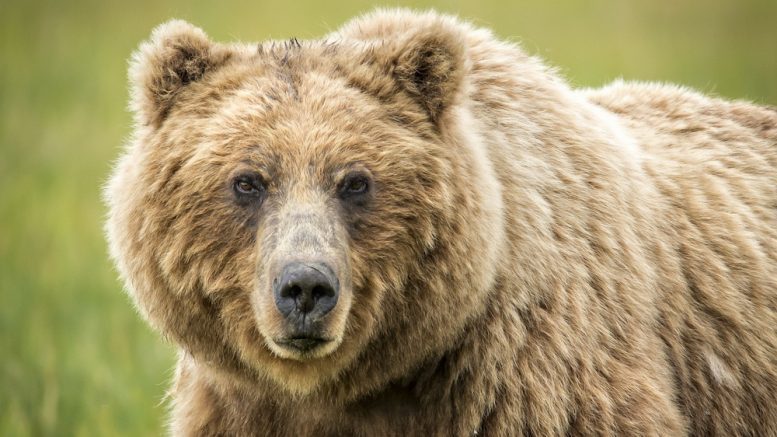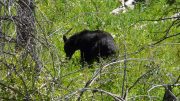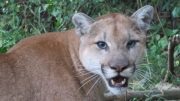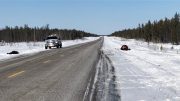In the evening of Sunday, July 14, two American tourists in the Hanbury Lake area, 480 kilometres east of Yellowknife, found a grizzly bear shredding their foldable canoe.
They sent a distress call to the International Emergency Response Coordination Centre, a global search and rescue dispatch centre, which relayed the message to Yellowknife RCMP. In an email, RCMP media relations officer Julie Plourde told CKLB the detachment only received the information around midnight. She added that while officers couldn’t fly out at night, they confirmed the couple didn’t have any injuries and “managed to shelter away from the bear threat while waiting for rescue.”
The next morning, RCMP shared the information with the territorial Department of Environment and Natural Resources.
Lee Mandeville was one of two ENR officers sent to retrieve the tourists. He said they arrived at the site in the early afternoon—more than 12 hours after the couple sent the initial distress call.
According to Mandeville, the couple was pinned on a peninsula with the bear 30 to 40 feet away when officers arrived. The helicopter scared the bear away and then landed so officers could secure the area. Mandeville said the tourists “seemed alright, I think they were just exhausted, a little shaken up.”
Rather than leave with the tourists, the officers decided to track the bear but determined it was too risky to do so on foot. Instead, they removed a door from the helicopter and flew back into the air.
Mandeville didn’t say how long it took to find the animal, but he ended up shooting it from the helicopter. He said he made the decision “in the heat of the moment” and to prevent any other human encounters in the area.
The officers then landed once more to collect samples from the bear to test if it had any illnesses.
Bear encounters
ENR said this was the third human-bear encounter in three years in the Hanbury Lake area. In 2017, campers were apparently “chased into their canoe” and had to be picked up by officers downstream, and in 2018, a group saw a bear near their camp but “had experienced no negative encounters” before leaving the area.
CKLB asked if the bear in question had been tagged or tracked to confirm it was the same animal in all three instances. ENR communications manager Meagan Wohlberg didn’t say if it had been tagged. Instead, she wrote, “ENR believes there is a reasonable probability that the bear destroyed earlier this week may have been the same bear and that it had become gradually habituated to campsites over the past several years.”
Department response
That’s the only information the department would share.
After our interview with Mandeville, CKLB wanted to understand what rules govern when officers can shoot an animal.
Section 56 (2) of the territory’s Wildlife Act states, “a person may kill wildlife if it is necessary to prevent injury or death to a person.”
One could argue that injury or death was prevented when the bear was scared off by the helicopter. To be clear, CKLB is not suggesting there needs to be a death or severe injury to justify an officer shoot a wild animal. But by the time Mandeville returned to the air, the tourists were safe.
We also requested a history of ENR officers putting down animals in the last five years, knowing that they destroyed at least one other bear earlier this year in the Liard region.
Initially, Wohlberg said it would take “considerable time” to gather this history. Before CKLB could respond, she sent another email saying, “We have considered your additional follow up questions further and ENR is of the position that we already provided you with sufficient information with which to complete your story,” effectively refusing to answer any more questions.
CKLB amended the request for the history to include just the past two years. We again requested information on what governs officer interaction with wildlife, other than the specified section of the Wildlife Act. Finally, we asked if Mandeville’s action were in line with ENR policies.
The department has seen our follow up but has not answered the second request.
Tranquilized?
During our interview with Mandeville, we asked if officers could have tranquilized the bear. He said, “there wasn’t an opportunity” to do so. He reiterated he acted in the “heat of the moment” and added, “sometimes you have to make quick decisions.” But by then, the tourists were safe and the officers made the decision to remove a helicopter door.
Mandeville continued, “It’s a rare thing to have to put animals down and it’s the last thing we want to do. Our job is to conserve animals… we care deeply about animal safety.”
Officers may say that shooting an animal is a last resort, and there are certainly times where that is warranted, but this is the second incident—at least—this year; without a clear indication of how often animals are destroyed and what ENR rules govern officers’ engagement in this behaviour, the public is left to accept decisions made “in the heat of the moment.”
Francis was a reporter with CKLB from January 2019 to March 2023. In his time with CKLB, he had the immense pleasure and honour of learning about northern Indigenous cultures.









